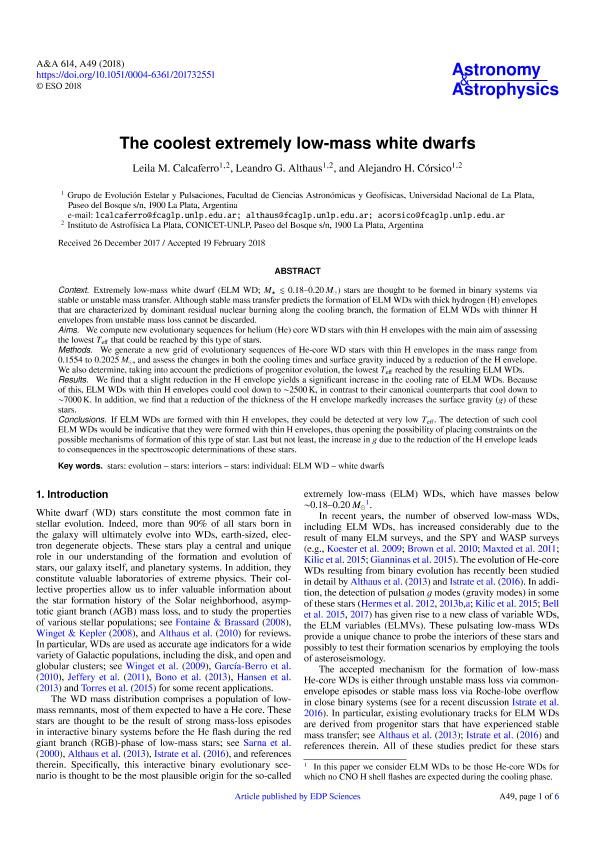Mostrar el registro sencillo del ítem
dc.contributor.author
Calcaferro, Leila Magdalena

dc.contributor.author
Althaus, Leandro Gabriel

dc.contributor.author
Corsico, Alejandro Hugo

dc.date.available
2019-09-04T17:23:14Z
dc.date.issued
2018-02
dc.identifier.citation
Calcaferro, Leila Magdalena; Althaus, Leandro Gabriel; Corsico, Alejandro Hugo; The coolest extremely low-mass white dwarfs; EDP Sciences; Astronomy and Astrophysics; 614; 2-2018
dc.identifier.issn
0004-6361
dc.identifier.uri
http://hdl.handle.net/11336/82883
dc.description.abstract
Context. Extremely low-mass white dwarf (ELM WD; M∗ ≲ 0.18-0.20 M⊙) stars are thought to be formed in binary systems via stable or unstable mass transfer. Although stable mass transfer predicts the formation of ELM WDs with thick hydrogen (H) envelopes that are characterized by dominant residual nuclear burning along the cooling branch, the formation of ELM WDs with thinner H envelopes from unstable mass loss cannot be discarded. Aims. We compute new evolutionary sequences for helium (He) core WD stars with thin H envelopes with the main aim of assessing the lowest Teff that could be reached by this type of stars. Methods. We generate a new grid of evolutionary sequences of He-core WD stars with thin H envelopes in the mass range from 0.1554 to 0.2025 M≲, and assess the changes in both the cooling times and surface gravity induced by a reduction of the H envelope. We also determine, taking into account the predictions of progenitor evolution, the lowest Teff reached by the resulting ELM WDs. Results. We find that a slight reduction in the H envelope yields a significant increase in the cooling rate of ELM WDs. Because of this, ELM WDs with thin H envelopes could cool down to 2500 K, in contrast to their canonical counterparts that cool down to 7000 K. In addition, we find that a reduction of the thickness of the H envelope markedly increases the surface gravity (g) of these stars. Conclusions. If ELM WDs are formed with thin H envelopes, they could be detected at very low Teff. The detection of such cool ELM WDs would be indicative that they were formed with thin H envelopes, thus opening the possibility of placing constraints on the possible mechanisms of formation of this type of star. Last but not least, the increase in g due to the reduction of the H envelope leads to consequences in the spectroscopic determinations of these stars.
dc.format
application/pdf
dc.language.iso
eng
dc.publisher
EDP Sciences

dc.rights
info:eu-repo/semantics/openAccess
dc.rights.uri
https://creativecommons.org/licenses/by-nc-sa/2.5/ar/
dc.subject
Stars: Evolution
dc.subject
Stars: Individual: Elm Wd
dc.subject
Stars: Interiors
dc.subject
White Dwarfs
dc.subject.classification
Astronomía

dc.subject.classification
Ciencias Físicas

dc.subject.classification
CIENCIAS NATURALES Y EXACTAS

dc.title
The coolest extremely low-mass white dwarfs
dc.type
info:eu-repo/semantics/article
dc.type
info:ar-repo/semantics/artículo
dc.type
info:eu-repo/semantics/publishedVersion
dc.date.updated
2019-08-30T14:28:41Z
dc.journal.volume
614
dc.journal.pais
Francia

dc.journal.ciudad
París
dc.description.fil
Fil: Calcaferro, Leila Magdalena. Consejo Nacional de Investigaciones Científicas y Técnicas. Centro Científico Tecnológico Conicet - La Plata. Instituto de Astrofísica La Plata. Universidad Nacional de La Plata. Facultad de Ciencias Astronómicas y Geofísicas. Instituto de Astrofísica La Plata; Argentina
dc.description.fil
Fil: Althaus, Leandro Gabriel. Consejo Nacional de Investigaciones Científicas y Técnicas. Centro Científico Tecnológico Conicet - La Plata. Instituto de Astrofísica La Plata. Universidad Nacional de La Plata. Facultad de Ciencias Astronómicas y Geofísicas. Instituto de Astrofísica La Plata; Argentina
dc.description.fil
Fil: Corsico, Alejandro Hugo. Consejo Nacional de Investigaciones Científicas y Técnicas. Centro Científico Tecnológico Conicet - La Plata. Instituto de Astrofísica La Plata. Universidad Nacional de La Plata. Facultad de Ciencias Astronómicas y Geofísicas. Instituto de Astrofísica La Plata; Argentina
dc.journal.title
Astronomy and Astrophysics

dc.relation.alternativeid
info:eu-repo/semantics/altIdentifier/doi/https://doi.org/10.1051/0004-6361/201732551
dc.relation.alternativeid
info:eu-repo/semantics/altIdentifier/url/https://www.aanda.org/10.1051/0004-6361/201732551
Archivos asociados
